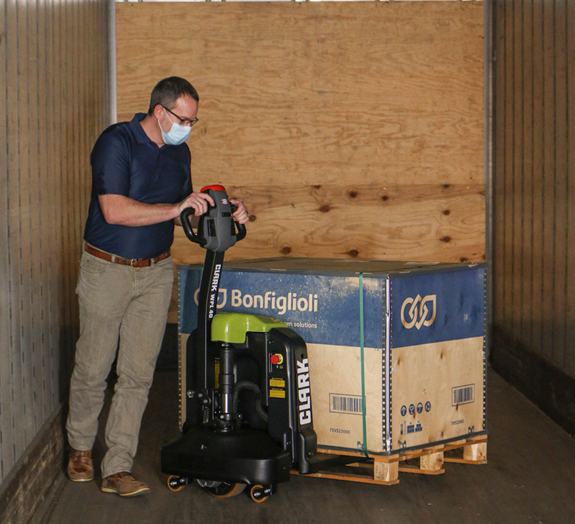Pallet Jack Safety 101 – Tools to Keep Your Team Moving Safely
Pallet jacks are ubiquitous in the material handling world. They’re handy, easy to operate, and a cost-effective way to handle a variety of warehousing activities. So, what’s the downside? Because they are so accessible, it’s a little easier to overlook pallet jack safety. Where you wouldn’t let operational procedures slide while working with larger equipment, you may with a pallet jack. The result can cause significant harm to your workers, operational effectiveness, and your bottom line.
We use pallet jacks to carry very heavy loads. Some pallet jacks can handle up to 5,500 lb. That’s as much as a Ford F-150. You don’t want that thing falling on your foot.
As with all material handling equipment like forklifts, stackers, and pickers, training is the key to pallet jack safety and efficiency. Sign up with Apex and have your warehouse and plant personnel get top-notch pallet jack safety training on these seemingly simple devices.
Here are some guidelines on the safe and efficient use of pallet jacks –
- Inspect your pallet jack before using it. Ensure the hydraulic lift is working properly by testing it without a load. Inspect the main steer wheels, forks, and fork rollers for damage or cracks.
- Use appropriate personal protection equipment. Use gloves if you will be unloading heavy or abrasive material. Use eye protection if moving caustic or toxic liquids.
- Do not exceed the weight-bearing capacity of your pallet jack. Confirm the weight of your load and the capacity of the pallet jack before attempting to lift and move a loaded pallet.
- Center the load evenly under the forks laterally so that the load won’t tip over. Insert forks all the way into the pallet to ensure balanced weight distribution.
- Generally, push the load rather than pull it if possible. This will allow you to see where you are headed. Also, pushing uses your legs to propel the load, whereas pulling can put a strain on your back. But, if you have to pull the load, use caution and be sure to know what’s in front of you.

- Maintain a clearance of 1 in. between the pallet and the floor. Be aware of uneven floor levels and move cautiously over them, especially with a heavily loaded pallet jack.
- When moving a loaded pallet jack, maintain a speed that will give you sufficient time to stop if a sudden obstacle appears. A 5,000 lb. load carries a lot of momentum when in motion. Many injuries to hands or fingers occur from trying to stop a moving pallet jack from hitting a stationary object.
- Be careful turning a loaded pallet jack. A sharp turn can cause the load to tip over.
- Never position your feet under a loaded and raised pallet jack under any circumstance. Wear steel-tipped safety shoes, if available.
- If you’re moving down an incline, have the pallet jack positioned downhill from you.
- When lowering a loaded pallet jack, alert any co-workers to stand clear. Come to a complete stop before lowering a pallet jack.
- Plan out the route you are going to take with the pallet jack. Remove obstacles and hazards before starting your move.
- Maintain visibility of where the pallet jack is headed. If your load is so high that you can’t see over it, ask a coworker to help out. Sometimes, pallet jack safety requires teamwork.
- Pallet jacks are simple but require maintenance. Have hydraulic fluid levels checked regularly. Replace worn, chipped, or cracked wheels and rollers.
- Store pallet jacks in a dry area with their forks lowered.

Additional tips for using electric-powered pallet jacks –
- When traveling with a loaded electric pallet jack, the operator should be in front–just the opposite of using a manual pallet jack. This allows the operator to determine the route the pallet jack will take more accurately.
- With an electric pallet jack, your pre-use inspection protocol includes confirming that the battery is fully charged and that the drive motor is operating properly. Do not use a motorized pallet jack that moves in a jerky, inconsistent manner.
Pallet jack safety awareness and training are tantamount to the proper operation of all material handling equipment, and pallet jacks are no exception. Apex offers training for all types of material handling equipment, from humble manual pallet jacks to the most advanced telescoping telehandlers. You can trust Apex to provide the products and services you need to keep your Chicago-area fleet of material handling equipment running in tip-top shape.
Contact the Apex team for equipment, training, service, and all your warehouse vehicle needs.
